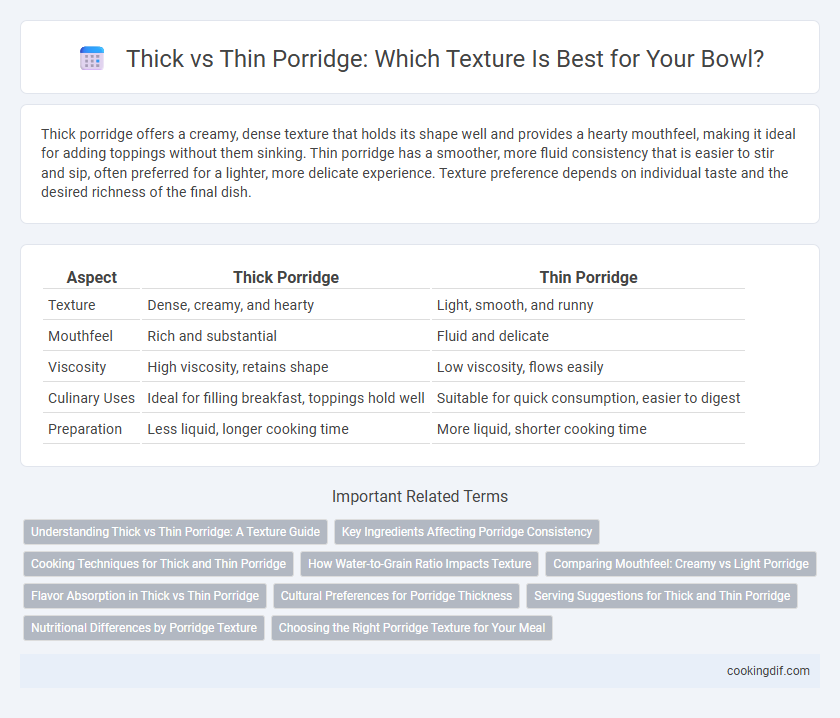Thick porridge offers a creamy, dense texture that holds its shape well and provides a hearty mouthfeel, making it ideal for adding toppings without them sinking. Thin porridge has a smoother, more fluid consistency that is easier to stir and sip, often preferred for a lighter, more delicate experience. Texture preference depends on individual taste and the desired richness of the final dish.
Table of Comparison
| Aspect | Thick Porridge | Thin Porridge |
|---|---|---|
| Texture | Dense, creamy, and hearty | Light, smooth, and runny |
| Mouthfeel | Rich and substantial | Fluid and delicate |
| Viscosity | High viscosity, retains shape | Low viscosity, flows easily |
| Culinary Uses | Ideal for filling breakfast, toppings hold well | Suitable for quick consumption, easier to digest |
| Preparation | Less liquid, longer cooking time | More liquid, shorter cooking time |
Understanding Thick vs Thin Porridge: A Texture Guide
Thick porridge features a dense, creamy texture that holds its shape well, offering a rich mouthfeel perfect for toppings like nuts and fruits. Thin porridge has a more fluid consistency, making it easier to spoon and ideal for a lighter meal or for those who prefer a smoother, less filling option. Adjusting water-to-grain ratios controls porridge thickness, directly influencing its texture and eating experience.
Key Ingredients Affecting Porridge Consistency
The consistency of porridge is primarily influenced by the ratio of liquid to grain, with thicker porridge requiring less liquid and more oats or cornmeal, resulting in a dense, creamy texture. Key ingredients such as type of grain, starch content, and cooking time also play critical roles; for example, steel-cut oats create a chewier texture while rolled oats yield a smoother porridge. Adjusting the liquid--water, milk, or broth--and cooking temperature allows precise control over thickness, making it easy to customize porridge from thick and hearty to thin and soupy.
Cooking Techniques for Thick and Thin Porridge
Thick porridge achieves its dense texture by using a higher grain-to-liquid ratio and prolonged simmering, which allows starches to gelatinize fully, resulting in a creamy consistency. Thin porridge requires more liquid and shorter cooking times, producing a smooth, pourable texture ideal for easy digestion. Adjusting cooking techniques, such as stirring frequency and heat control, directly influences the final thickness and mouthfeel of the porridge.
How Water-to-Grain Ratio Impacts Texture
The water-to-grain ratio critically determines the texture of porridge, where a higher ratio results in a thinner, more fluid consistency, while a lower ratio produces a thicker, creamier texture. Thick porridge often uses less water, allowing grains like oats or millet to absorb more moisture and swell, creating a dense, hearty meal. Thin porridge, with more water, yields a lighter, soup-like texture that is easier to digest and preferred for quick consumption or as a base for additional ingredients.
Comparing Mouthfeel: Creamy vs Light Porridge
Thick porridge offers a creamy, rich mouthfeel that coats the palate with a velvety texture, making it satisfying and hearty. Thin porridge provides a light, smooth consistency that feels refreshing and easy to swallow, ideal for a delicate breakfast experience. The choice between thick and thin porridge depends on personal preference for texture and the desired sensory experience during consumption.
Flavor Absorption in Thick vs Thin Porridge
Thick porridge has a dense texture that enhances flavor absorption by allowing spices and ingredients to meld deeply into each spoonful, creating a rich and satisfying taste experience. Thin porridge, with its watery consistency, dilutes flavors due to higher moisture content, resulting in a lighter and more subtle taste profile. The choice between thick and thin porridge significantly impacts the intensity and duration of flavor on the palate.
Cultural Preferences for Porridge Thickness
Thick porridge often prevails in Northern European and African culinary traditions, where hearty textures are preferred for their warming and filling qualities. Thin porridge, common in Asian and some Mediterranean cultures, emphasizes smoothness and ease of digestion, aligning with lighter meal customs. These cultural preferences reflect differing nutritional needs and historical food availability, shaping the unique textures of porridge around the world.
Serving Suggestions for Thick and Thin Porridge
Thick porridge offers a creamy, dense texture perfect for toppings like fresh fruits, nuts, and honey, enhancing each spoonful's richness. Thin porridge provides a lighter, more fluid consistency ideal for blending with spices, milk, or savory ingredients such as herbs and cheese, making it versatile for breakfast or light meals. Serving thick porridge in bowls emphasizes its hearty nature, while thin porridge is often served in deeper dishes or cups for easy sipping.
Nutritional Differences by Porridge Texture
Thick porridge typically has a higher concentration of nutrients per serving due to less water content, providing more calories, fiber, and protein that contribute to satiety and sustained energy release. Thin porridge, with increased water content, offers easier digestibility and hydration but may provide fewer calories and reduced nutrient density, making it suitable for light meals or those requiring soft-textured foods. Selecting thick or thin porridge impacts glycemic response and nutrient absorption, influencing dietary planning for energy levels and digestive health.
Choosing the Right Porridge Texture for Your Meal
Thick porridge offers a creamy, hearty texture that provides a satisfying mouthfeel and keeps you full longer, making it ideal for breakfast meals aiming for sustained energy. Thin porridge, with its lighter and more fluid consistency, is easier to digest and perfect for lighter meals or when a gentle texture is preferred. Selecting between thick and thin porridge depends on nutritional goals, digestion needs, and personal texture preferences to optimize your meal experience.
Thick porridge vs Thin porridge for texture Infographic

 cookingdif.com
cookingdif.com